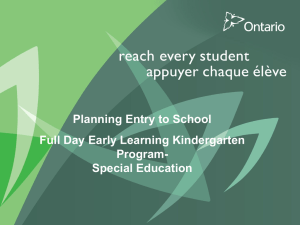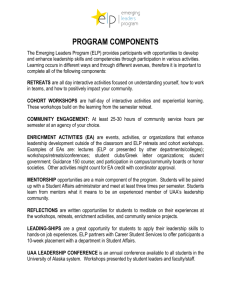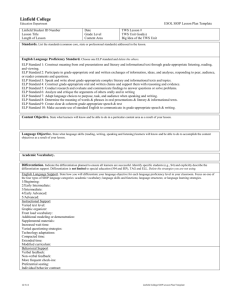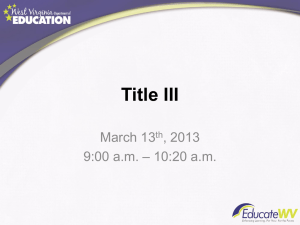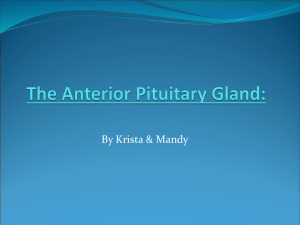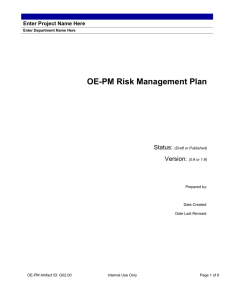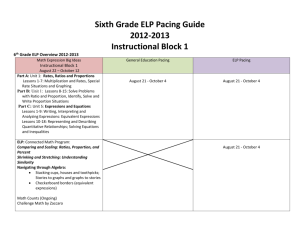Introducing the CERCLES European Language
advertisement
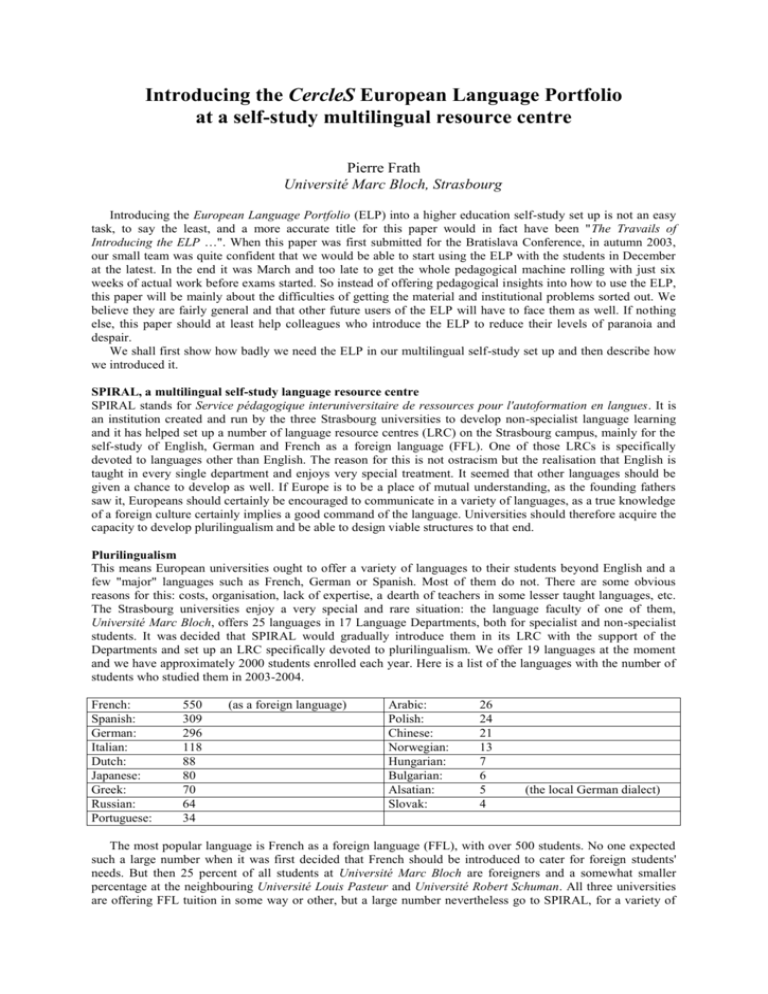
Introducing the CercleS European Language Portfolio at a self-study multilingual resource centre Pierre Frath Université Marc Bloch, Strasbourg Introducing the European Language Portfolio (ELP) into a higher education self-study set up is not an easy task, to say the least, and a more accurate title for this paper would in fact have been "The Travails of Introducing the ELP …". When this paper was first submitted for the Bratislava Conference, in autumn 2003, our small team was quite confident that we would be able to start using the ELP with the students in December at the latest. In the end it was March and too late to get the whole pedagogical machine rolling with just six weeks of actual work before exams started. So instead of offering pedagogical insights into how to use the ELP, this paper will be mainly about the difficulties of getting the material and institutional problems sorted out. We believe they are fairly general and that other future users of the ELP will have to face them as well. If nothing else, this paper should at least help colleagues who introduce the ELP to reduce their levels of paranoia and despair. We shall first show how badly we need the ELP in our multilingual self-study set up and then describe how we introduced it. SPIRAL, a multilingual self-study language resource centre SPIRAL stands for Service pédagogique interuniversitaire de ressources pour l'autoformation en langues. It is an institution created and run by the three Strasbourg universities to develop non-specialist language learning and it has helped set up a number of language resource centres (LRC) on the Strasbourg campus, mainly for the self-study of English, German and French as a foreign language (FFL). One of those LRCs is specifically devoted to languages other than English. The reason for this is not ostracism but the realisation that English is taught in every single department and enjoys very special treatment. It seemed that other languages should be given a chance to develop as well. If Europe is to be a place of mutual understanding, as the founding fathers saw it, Europeans should certainly be encouraged to communicate in a variety of languages, as a true knowledge of a foreign culture certainly implies a good command of the language. Universities should therefore acquire the capacity to develop plurilingualism and be able to design viable structures to that end. Plurilingualism This means European universities ought to offer a variety of languages to their students beyond English and a few "major" languages such as French, German or Spanish. Most of them do not. There are some obvious reasons for this: costs, organisation, lack of expertise, a dearth of teachers in some lesser taught languages, etc. The Strasbourg universities enjoy a very special and rare situation: the language faculty of one of them, Université Marc Bloch, offers 25 languages in 17 Language Departments, both for specialist and non-specialist students. It was decided that SPIRAL would gradually introduce them in its LRC with the support of the Departments and set up an LRC specifically devoted to plurilingualism. We offer 19 languages at the moment and we have approximately 2000 students enrolled each year. Here is a list of the languages with the number of students who studied them in 2003-2004. French: Spanish: German: Italian: Dutch: Japanese: Greek: Russian: Portuguese: 550 309 296 118 88 80 70 64 34 (as a foreign language) Arabic: Polish: Chinese: Norwegian: Hungarian: Bulgarian: Alsatian: Slovak: 26 24 21 13 7 6 5 4 (the local German dialect) The most popular language is French as a foreign language (FFL), with over 500 students. No one expected such a large number when it was first decided that French should be introduced to cater for foreign students' needs. But then 25 percent of all students at Université Marc Bloch are foreigners and a somewhat smaller percentage at the neighbouring Université Louis Pasteur and Université Robert Schuman. All three universities are offering FFL tuition in some way or other, but a large number nevertheless go to SPIRAL, for a variety of 2 Pierre Frath reasons (more convenient access, other resources, regular workshops, the opportunity to meet French students learning their language, etc.). Most of these students now come from outside the Francophone zone, quite often from parts of the world where French is not much taught in secondary schools, such as Eastern Europe, Russia and the Far East. The students' level of French is therefore often inadequate and they are quite happy to be offered flexible means for improving their skills. The second most popular languages are German and Spanish, with about 300 students each. Spanish enjoys the same sort of growing popularity in France as everywhere else in the world (for reasons it would probably be interesting to research). German is the runner up mainly for local reasons: most natives in Alsace speak Alsatian, a German dialect, and many students recognise that a good command of German is certainly an advantage on the local job market. Also, the international value of German remains very high, especially in Central and Eastern Europe. The problem is that many departments only offer English, and if it were not for SPIRAL, many students would have to lose touch with German during their studies. Italian is also very popular, probably because of a reputation of easiness for speakers of French and a very positive image of Italy. The surprisingly high numbers in Dutch and Greek are due to the dynamism of the Dutch and Greek Departments of the Language Faculty, which shows that a deliberate and enthusiastic policy can be an important factor for student motivation. Japanese is growing largely because the Strasbourg universities have developed strong ties with Japanese universities and many students hope to spend some time in Japan. Russian is up, probably because Russia is an attractive country for many French people; Arabic is down, and maybe the disastrous political situation in the Muslim world is a factor; the other languages attract a few learners, too few, certainly, but the numbers are increasing. Alsatian has not been very popular this year; it was only introduced in February and this was too late for the main target audience, the medical students, who want to be able to communicate with the older local generation, who do not speak much French. Persian and Hebrew were introduced very recently and Persian managed to attract a few dedicated students. We hope this will also be the case with Hebrew next year. The case for the Portfolio One of our main problems at SPIRAL is lack of institutional validation. Students attend the LRC as they please and their motivation can therefore be quite fragile, as their desire to learn languages suffers from competition with other more entertaining and more immediately rewarding activities. There are no examinations and the work accomplished by students at SPIRAL remains unrecorded by their departments and is not mentioned on their diploma. Evaluation is at any rate an inherent problem of self-study. If students are free to study what and how much they want, there can be, by definition, no standard. On top of that, because of a dearth of qualified teachers in many languages, we rely on native student monitors, who are not qualified to mark exams. Also, regular examinations in 19 languages for 2000 students would require a level of organisation and manpower that our small team of 6 part-time teachers could not provide. This is why we decided to introduce the European Language Portfolio (ELP). The six levels of proficiency offered by the Common European Framework of Reference (CEFR) now enjoy international recognition and transparency, and most certification institutions have pegged their own examinations on them. The CEFR descriptors are certainly a good tool for assessment and self-assessment and we thought they could help us achieve a flexible means of evaluation. The idea is to validate student self-assessment. Students are encouraged to use the Passport to state their level, and they are asked to offer evidence of that level in the Dossier. For example, a student claiming he has reached level B2 in reading Japanese can put a newspaper article or a chapter of a book he can understand in the Dossier. After a certain period of learning, the students can be asked to submit their Dossiers to a jury who will then support their claim (or not), and give them a mark, if required by the students' departments. The university departments will be relieved from the trouble of organising language tuition. All they will have to do is give the students incentives to learn languages and to reach a specified level, and finance the evaluation. We hope this will make the departments more language-conscious and foster more student involvement in language learning beyond English. A beneficial side effect of the Dossier will be to give students a better sense of purpose. One of the known problems with self-study is insecurity about the work that has been achieved and the planning of future steps. What have I done so far? Is it good enough? What should I do next? The need to prepare a Dossier will give students a clear objective. Also, resources will be used less passively, since creating proof of excellence implies an actual use of the language. What has been achieved so far? When we first heard of the ELP back in 2000, we immediately knew that this was a solution to our problem. Since no student ELP was available at the time, we created our own and submitted it for accreditation by the Council of Europe (CoE) twice in 2001. Unfortunately, our ELP was rejected by the committee. It seems we were the first to undergo the accreditation procedure from outside the inner circle of the experimenting team, and Introducing the CercleS ELP at a self-study multilingual resource centre 3 all the features of a regular ELP had not yet been spelled out in the CoE's publications. We stopped trying when we learned that CercleS was designing its own ELP, and decided to wait. We have been using the Self Assessment grid of the Passport for two years as a positioning tool for new students when they first come to SPIRAL. During a follow up interview with a teacher, they are then asked to state their objectives, so that they will be able to know if and when they have reached them. We hope the international value of the ELP will increase student motivation for languages and self-assessment. We have also been compiling lists of resources to specifically reach levels A1 and A2 in listening and reading comprehension in some languages: Greek, French, Dutch, German, Arabic and Spanish. These lists are on our website for students to consult and they should help them choose useful resources, which is an especially difficult task for beginners. The CercleS ELP was officially launched at the 2002 Paris Conference at Dauphine, and we acquired an electronic version from RANACLES in spring 2003. We had first hoped to be able to introduce the ELP in September 2003, but this was vastly over-optimistic. We had then postponed our hopes to December or January at the latest, and it is now October 2004. The problems we had to face were quite varied, some technical, some institutional, some pedagogical. Technical difficulties The CercleS ELP comes as a pdf file with a password for reading and printing it. No changes are allowed. The problem is that there are quite a large number of mistakes, especially in the French version. There are spelling mistakes (for example europeén on page 1 of the Passport), technical mistakes (for example some of the frames in the Checklist Section are too small to take the longer French version and have to be enlarged), and there are also some awkward French translations. For example, your second languages was translated as vos deuxièmes langues, whereas as vos langues secondes would have been correct. We offered to make the necessary changes for CercleS and submit them for validation but we got no answer. In the end, we managed to make minimal corrections, such as the wrongly placed accent in européen, which we could not bring ourselves to publish as it was. The fact that there was no debate on those matters on the CercleS and the RANACLES mailing lists seems a little surprising. Surely such a large number of mistakes should have been noticed. Could it be that no university has actually used the ELP since 2002? Another undiscussed problem was the design of the ELP. When we first got the pdf file, we printed and photocopied it to use as a working document and hand out for training sessions. It was soon quite obvious that it was very difficult to use. It was quite hard to distinguish between the sections and it was all seemed very confusing. Evidently, not much thought had been given to the ELP as an object. After a while, we got the idea of a plastic folder containing four booklets of different colours: the Passport in blue, the Biography in orange, the Dossier in grey and the Checklists in beige. The contents of the Biography are made up of loose sheets to be photocopied. The folder displays a home-made cover with the logos of the universities and of SPIRAL. The next problem was printing. Luckily, Université Marc Bloch has an efficient publishing department and things went smoothly. The only problem was that they flatly refused to assemble the booklets and the other bits and pieces which constitute the ELP. So we asked a few students to help us and the 1500 copies of the ELP were assembled within a fortnight. Université Louis Pasteur took the opportunity to have 2000 extra copies printed for their first year students. We then thought we did not want to go through this strenuous process year after year and we would rather send the students to the bookshop across the street to buy their copy of the ELP. One of our colleagues made contact with someone from DIDIER, the publishing house which has published the children's and the young adults' Portfolio. Would they be interested in publishing the student ELP as well? They would love to. We asked permission from CercleS, who told us to first discuss the matter with RANACLES. After the Bratislava conference, CercleS has decided to set up a committee to look into the matter of publication. Institutional difficulties In the end, solving the material problems of the ELP, although quite a strenuous activity, was nothing when compared to the financial and institutional problems we had to face. Some of these may be typically French and not of general interest. But then, most universities in most countries probably have their own particular ways of stultifying initiative and colleagues in Europe might find it interesting to compare varieties of Kafkaesque nightmares. The production cost of our ELP is about 4 euros. Who will pay for it? There is a strong tradition in France that education should be as free of charge as possible and student unions bitterly fight each and every increase in the Droits d'Inscription. As a result, fees are much lower in France then in most countries, about 250 euros a year. So adding the cost of the ELP to tuition fees was not an option. Would, then, the university finance it on its budget? This was what Université Louis Pasteur decided to do with their 2000 copies of the ELP. Unfortunately, this was not possible at SPIRAL, for a variety of reasons, which are too particular to be of interest here. The only solution left was to sell the ELP to the students individually. This means SPIRAL had to pay for its 1500 copies 4 Pierre Frath of the ELP on its own budget and will have to wait for the money to trickle in next academic year. Fortunately, we had the 6000 euros in our budget. Unfortunately, strict accounting regulations force us to fill in a slip of paper for each of the ELPs that we sell, stating the name of the student, the price and the means of payment. Also, now that the ELPs have a commercial value, the stock must be locked up in a safe place and each single copy must be accounted for. Since we have no administrative staff, this extra work burdens the teaching staff. Such is the price of enthusiasm and innovation. On the institutional front, things were in a morass until very recently. The situation has somewhat cleared up in the last few weeks1. The ELP was given official recognition by the University Boards2 which have authority over policy. This is certainly a very good thing. On the other hand, details were not specified and the departments have not yet been made conscious of their role in developing their own language policy. We hope to be able to make progress in these matters during the coming academic year. Also, it is not clear how (or if) Portfolio-type evaluations can be used in departments where classroom teaching is prevalent. Pedagogical difficulties The use of the ELP at SPIRAL is based on combining the Passport with the Dossier, leaving aside the Language Biography. We believe the Biography is more of a teacher's tool to motivate students and help them organise their learning. Since SPIRAL is a self-study set up, teachers are not as present as in classroom teaching, and we fear a proper use of the Biography would be very difficult. As a consequence, while the use of the Passport and the Dossier is official SPIRAL policy, we leave the decision to use the Biography to individual teachers and to the students. The ELP is now selling well at SPIRAL, as it has become evident that its use has been sanctioned by official university policy. But before that, between March and June 2004, sales were not brisk, to say the least. We had only sold about 50 copies at the end of the academic year, although information had been sent out with posters, leaflets and training sessions with small groups of students whom we had asked if they would be interested in learning about the ELP. We also launched an information campaign in some regular language classes outside SPIRAL but very few students actually acquired the ELP and we have no idea about how, or if, they have actually used it. The most interested students were those engaged in didactics and teacher training, as everyone has heard of the ELP and is curious. The sad conclusion is that the ELP probably has no future without a very intensive institutional and pedagogical investment. Students will only use it if they know it is official policy, if they see it used to their advantage, and if they are properly trained in how to use it. This requires the participation of a large number of language teachers and this in turn means in-service teacher training. Experience has shown that university teachers are not very interested in non-specialist language learning, especially by self-study means in LRCs. Also, they tend to think highly of their teaching skills. As a result, most do not attend training sessions and seminars. Even if they did, we fear many of them would reject the ideas behind the ELP. For those who do attend training sessions, the majority appreciate the ELP and its humanistic views of the language-learner. Yet, when they are back in their departments, they find it is very difficult to implement the ELP with their students if the general set up is not geared towards a Portfolio view on language learning. And this brings us back to square one, the institutional morass. Conclusion It is probably a natural thing for innovation to go through a series of difficult stages. If this were not the case, change would be too easy, things would be changing all the time and life would be unbearable. It is also possible that when changes have actually taken place, benefits never live up to expectations, and disillusionment is ingrained in change. So maybe we should not worry too much about the difficulties and keep trying. This paper has outlined our own difficulties, local ones as well as fairly general ones, with the hope that it could be of help, or solace, to colleagues trying to introduce the ELP. We should be pleased to share our experience, and colleagues are most welcome to visit us at SPIRAL in Strasbourg3. Also, we would like to suggest that CercleS should give some thought to the practical means of production and distribution of the ELP, maybe with the help of publishers. And last but not least, it might be interesting for colleagues to have a series of guidelines listing the difficulties, the dos and don’ts, the problems encountered and the solutions that have been found 4. 1 October 2004 2 Conseil des Etudes et de la Vie Universitaire et Conseil d'Administration. 3 … and also to visit our website : http://u2.u-strasbg.fr/spiral 4 At the time this paper was finalised for publication (June 2005), the situation had not changed much. Introducing the CercleS ELP at a self-study multilingual resource centre Pierre Frath Département d'anglais UFR des Langues Vivantes Directeur de SPIRAL EA 1339 Linguistique et didactique des langues Université Marc Bloch 22 rue Descartes 67084 Strasbourg France Email: frath@umb.u-strasbg.fr Site: http://u2.u-strasbg.fr/spiral 5
